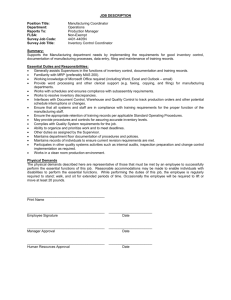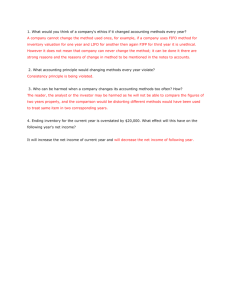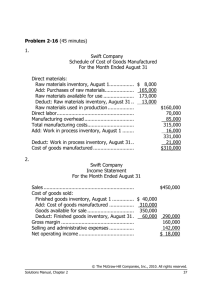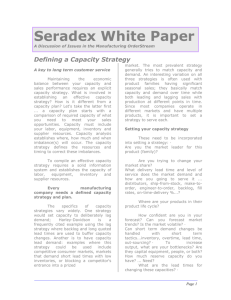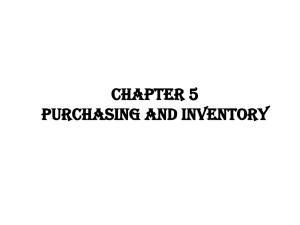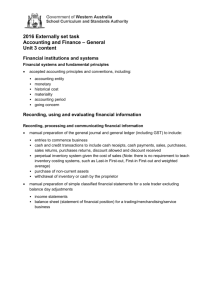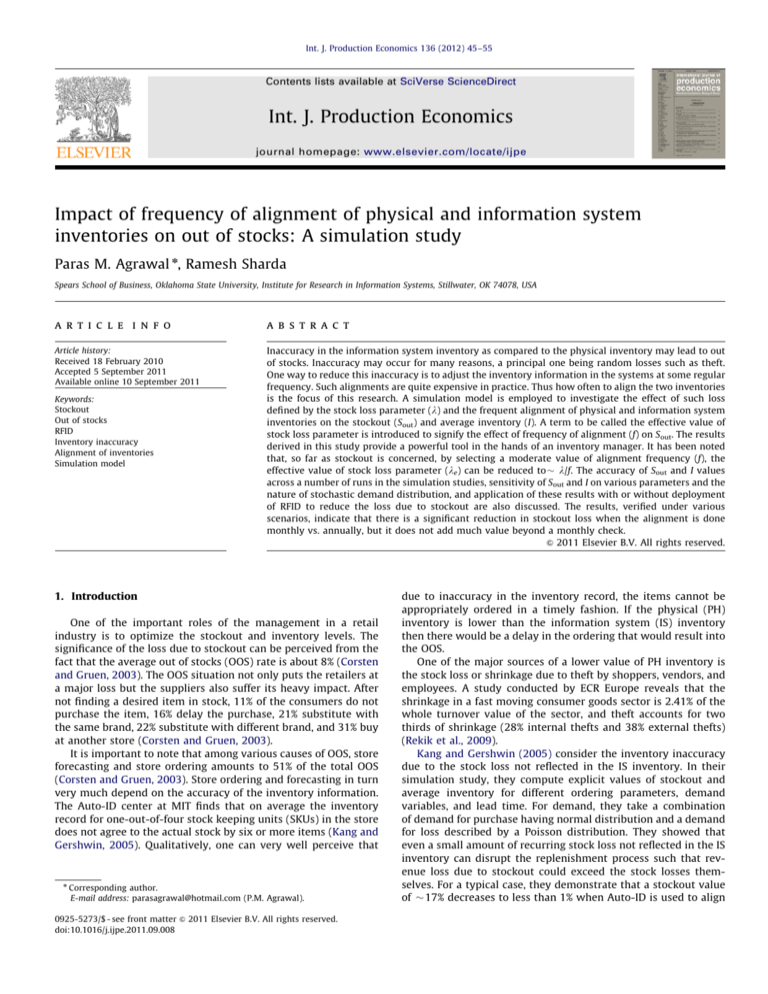
Int. J. Production Economics 136 (2012) 45–55
Contents lists available at SciVerse ScienceDirect
Int. J. Production Economics
journal homepage: www.elsevier.com/locate/ijpe
Impact of frequency of alignment of physical and information system
inventories on out of stocks: A simulation study
Paras M. Agrawal n, Ramesh Sharda
Spears School of Business, Oklahoma State University, Institute for Research in Information Systems, Stillwater, OK 74078, USA
a r t i c l e i n f o
abstract
Article history:
Received 18 February 2010
Accepted 5 September 2011
Available online 10 September 2011
Inaccuracy in the information system inventory as compared to the physical inventory may lead to out
of stocks. Inaccuracy may occur for many reasons, a principal one being random losses such as theft.
One way to reduce this inaccuracy is to adjust the inventory information in the systems at some regular
frequency. Such alignments are quite expensive in practice. Thus how often to align the two inventories
is the focus of this research. A simulation model is employed to investigate the effect of such loss
defined by the stock loss parameter (l) and the frequent alignment of physical and information system
inventories on the stockout (Sout) and average inventory (I). A term to be called the effective value of
stock loss parameter is introduced to signify the effect of frequency of alignment (f) on Sout. The results
derived in this study provide a powerful tool in the hands of an inventory manager. It has been noted
that, so far as stockout is concerned, by selecting a moderate value of alignment frequency (f), the
effective value of stock loss parameter (le) can be reduced to l/f. The accuracy of Sout and I values
across a number of runs in the simulation studies, sensitivity of Sout and I on various parameters and the
nature of stochastic demand distribution, and application of these results with or without deployment
of RFID to reduce the loss due to stockout are also discussed. The results, verified under various
scenarios, indicate that there is a significant reduction in stockout loss when the alignment is done
monthly vs. annually, but it does not add much value beyond a monthly check.
& 2011 Elsevier B.V. All rights reserved.
Keywords:
Stockout
Out of stocks
RFID
Inventory inaccuracy
Alignment of inventories
Simulation model
1. Introduction
One of the important roles of the management in a retail
industry is to optimize the stockout and inventory levels. The
significance of the loss due to stockout can be perceived from the
fact that the average out of stocks (OOS) rate is about 8% (Corsten
and Gruen, 2003). The OOS situation not only puts the retailers at
a major loss but the suppliers also suffer its heavy impact. After
not finding a desired item in stock, 11% of the consumers do not
purchase the item, 16% delay the purchase, 21% substitute with
the same brand, 22% substitute with different brand, and 31% buy
at another store (Corsten and Gruen, 2003).
It is important to note that among various causes of OOS, store
forecasting and store ordering amounts to 51% of the total OOS
(Corsten and Gruen, 2003). Store ordering and forecasting in turn
very much depend on the accuracy of the inventory information.
The Auto-ID center at MIT finds that on average the inventory
record for one-out-of-four stock keeping units (SKUs) in the store
does not agree to the actual stock by six or more items (Kang and
Gershwin, 2005). Qualitatively, one can very well perceive that
n
Corresponding author.
E-mail address: parasagrawal@hotmail.com (P.M. Agrawal).
0925-5273/$ - see front matter & 2011 Elsevier B.V. All rights reserved.
doi:10.1016/j.ijpe.2011.09.008
due to inaccuracy in the inventory record, the items cannot be
appropriately ordered in a timely fashion. If the physical (PH)
inventory is lower than the information system (IS) inventory
then there would be a delay in the ordering that would result into
the OOS.
One of the major sources of a lower value of PH inventory is
the stock loss or shrinkage due to theft by shoppers, vendors, and
employees. A study conducted by ECR Europe reveals that the
shrinkage in a fast moving consumer goods sector is 2.41% of the
whole turnover value of the sector, and theft accounts for two
thirds of shrinkage (28% internal thefts and 38% external thefts)
(Rekik et al., 2009).
Kang and Gershwin (2005) consider the inventory inaccuracy
due to the stock loss not reflected in the IS inventory. In their
simulation study, they compute explicit values of stockout and
average inventory for different ordering parameters, demand
variables, and lead time. For demand, they take a combination
of demand for purchase having normal distribution and a demand
for loss described by a Poisson distribution. They showed that
even a small amount of recurring stock loss not reflected in the IS
inventory can disrupt the replenishment process such that revenue loss due to stockout could exceed the stock losses themselves. For a typical case, they demonstrate that a stockout value
of 17% decreases to less than 1% when Auto-ID is used to align
46
P.M. Agrawal, R. Sharda / Int. J. Production Economics 136 (2012) 45–55
IS inventory with the PH inventory at the end of each period. They
also show that through RFID technology one can achieve the best
stockout-inventory compromise (the lowest inventory for any
given stockout), and the benefit of inventory accuracy provided
by RFID becomes greater as the desired level of stockout becomes
smaller.
We come across a number of studies dealing with RFID
technology (for reviews, e.g., see Alani et al., 2009; Angeles,
2005; Nambiar, 2009; Weier, 2009). Wal-Mart jump started the
RFID by a June 2003 mandate that its top 100 suppliers attach
tags on pallets and cases shipped to its stores in the Dallas, Texas
region. Despite the reluctance of a large number of retailers to
adopt the RFID technology due to initial investment in installing
RFID readers and associated software and the recurring cost of
RFID tags and other associated expenditures, the RFID technology
is being hailed as one of greatest contributions of the century
(Mehrjerdi., 2009). To derive benefits, studies related with cost
effectiveness (e.g., Ustundag and Tanyas, 2009; Miragliotta et al.,
2009; de Kok et al., 2008; Bottani and Rizzi, 2008), and new
innovative ideas of incorporating the technology (e.g., Heim et al.,
2009; Delen et al., 2007; Amini et al., 2007; Hardgrave et al.,
2006; Chongwatpol and Sharda, 2009) would prove valuable. The
search of innovative ways of reducing the lost sales due to OOS
with the help of RFID is one of the areas of interest.
We not only need innovative ways of employing RFID but we
also need to optimize the manner of using the data for operations.
For example, in exploring the possibility of reducing the OOS
situation by aligning the IS inventory with the PH inventory we
need to optimize the frequency of this alignment as each alignment costs significant human time even with RFID, though it is a
fraction of the time needed manually (Hardgrave, 2009; Hardgrave
et al., 2009). As mentioned earlier, Kang and Gershwin (2005) have
shown that the alignment of PH and IS inventories at the end of
each period leads to a quantum jump in the reduction of the OOS.
They also reported the amount of reduction in the stockout when
such an alignment is made twice within a total duration of 365
periods. There is a need to extend their results over a wider range
of frequencies and simulation parameters to study the impact of
frequency of alignment on OOS.
The purpose of this research is to advance our understanding
regarding the optimization of the frequency of counting the
physical inventory by investigating the relationship between the
stockout (Sout) and the frequency (f) of alignment of PH and IS
inventories under various conditions of demand, ordering, and
shrinkage, when the inventory record inaccuracy is due to stock
loss only. As the knowledge of average inventory (I) is valuable in
making any decision for the optimization, we shall also study the
variation in I with f. The possibility of finding an optimized value
of f would be explored by some numerical examples. For many
cases, we would see that there is a significant reduction of
stockout when the alignment is done monthly vs. annually, but
the additional advantage of going from monthly to daily is very
small. Other related aspects such as sensitivity of Sout and I on
various parameters, the effective value of the stock loss parameter
as a function of frequency (f), and the accuracy of computed
values of Sout and I in the simulation studies are also studied.
We describe the interesting new result showing a relationship
between an effective stock loss and the frequency of alignment
of physical and system inventory. As far as stockout is concerned,
by selecting a moderate value of alignment frequency (f),
the effective value of stock loss parameter (le) can be reduced
to l/f.
We first review some of the literature in the next section. In
Section 3, the simulation model developed for this study is
described. The results are then presented and discussed in
Section 4. Finally, the conclusions are described in the last section.
2. Literature review
As early as more than half a century back, Rinehart (1960)
highlighted the impact of discrepancies between IS and PH
inventories on a supply operation. Iglehart and Morey (1972)
investigated the proper frequency and depth of inventory counts
to minimize the total cost when there is likelihood of a discrepancy between the IS and PH inventories. More recently, Sandoh
and Shimamoto (2001) proposed a mathematical model to provide an optimal frequency for periodical inventory taking to
detect a gap between the IS and PH inventories in a retail store.
Fleisch and Tellkamp (2005) examined the relationship between
inventory inaccuracy and performance in a three-echelon retail
supply chain. In the base model, they align the PH and IS
inventories when the out-of-stock situation is detected. In the
modified model, IS inventory is aligned to PH inventory at the end
of each period. By comparing the results of these two models for
different parameters signifying theft, unsaleables, and the process
quality they show that elimination of inventory inaccuracy can
lead to the reduction in supply chain costs as well as stockout.
They also find that among the three factors studied, the inaccuracy caused by theft makes the biggest impact on supply chain
performance. They further point out that the RFID technology has
the potential to enhance the inventory accuracy.
Kok and Shang (2007) investigated an inspection adjusted
base-stock policy in which the manager performs an inspection if
the inventory recorded is less than a threshold level. By comparing the cost given by different policies, they also arrived at the
value of inventory information, which may be provided by RFID.
deHoratius and Raman (2008) examined nearly 370, 000 inventory records of one retailer having annual sales of approximately
$10 billion. They found 65% records to be inaccurate. As regards
the impact of this inaccuracy, in the last section of their paper,
deHoratius and Raman (2008) write, ‘‘We provide evidence that the
problem of record inaccuracy is substantial in magnitude in the retail
context. And the resulting lost sales can amount to a considerable
portion of firm profit.’’ Gumrukcu et al. (2008) employed the cycle
counting method (Young and Nie, 1992; Muller, 2003; Piasecki,
2003) using a simulation model in a two-echelon supply chain.
Their results show that the correct application of cycle counting
can lead to significant amount of saving for the supply chain.
Sahin et al. (2008) and Sahin and Dallery (2009) considered the
newsvendor type model to evaluate the economic impact of the
inaccuracies in the inventory records.
Rekik et al.(2009) considered a store in which PH inventory is
lower than the IS inventory due to theft. They compared three
approaches: (a) neither RFID technology is employed nor the
manager knows the errors occurring in the store, (b) RFID is not
employed but the manager takes advantage of having knowledge
of the errors, and (c) the advantage of a perfect RFID technology is
taken. By comparing the three approaches they analyze the
impact of the discrepancy in the PH and IS inventories due to
theft and the value of RFID. Based on their quantitative analysis,
they provided the optimal inventory policy for each approach.
Sethi (2010) observed that to address the problems related
with the incomplete inventory information the classical inventory
control approaches are inadequate and there is a need to develop
new approaches. Thiel et al. (2010) proposed analytical results as
well as simulation modeling to determine the impact of inventory
inaccuracy on the quality of service. Using several simulations,
they showed that loss in sale (stockout) is a non-monotone
function of the inventory inaccuracy rate. This result is in sharp
contrast with that of Kang and Gershwin (2005). The results of
Kang and Gershwin reveal that stockout is a monotone function of
the inaccuracy rate. It may be noted that Kang and Gershwin
(2005) consider the inventory inaccuracy due to shrinkage (theft



